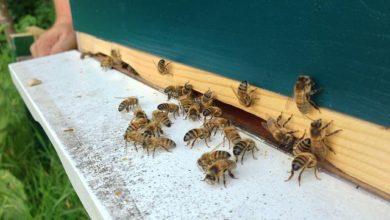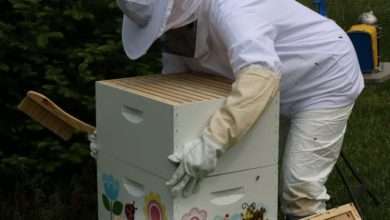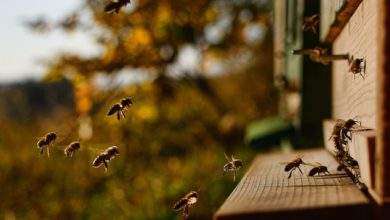Benefits of Using an Entrance Reducer in Beekeeping
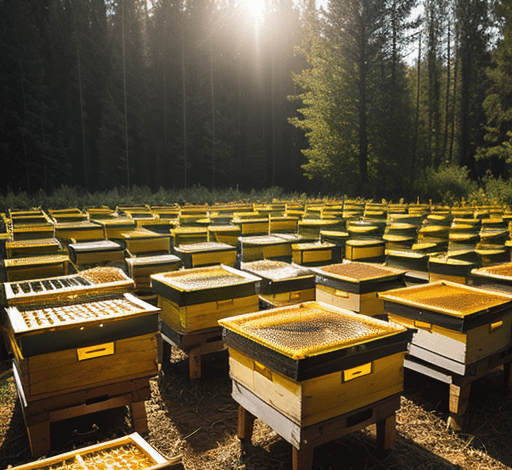
Beekeeping is a rewarding and valuable practice, but it requires careful management in order to ensure the health and productivity of the hive. One essential tool for successful beekeeping is the use of an entrance reducer. This simple device plays a crucial role in protecting the hive and its inhabitants from a variety of threats, while also helping to maintain a stable and supportive environment for the bees.
Explanation of an Entrance Reducer
An entrance reducer, as the name suggests, is a simple device used in beekeeping that reduces the size of the hive entrance. Typically made of wood or metal, it serves as a protective barrier, controlling the flow of traffic in and out of the hive. This mechanism acts as a regulator, reducing the entrance size during specific periods when required.
Purpose of Using an Entrance Reducer
The primary purpose of employing an entrance reducer in a beehive is to defend the colony against external threats while enabling better defense capabilities for the resident honeybees. Let’s explore the key motives for utilizing an entrance reducer:
- Temperature and Ventilation Control: An entrance reducer aids in maintaining a suitable internal temperature and ventilation within the hive. By reducing the size of the entrance, it minimizes heat loss during cooler seasons, helping the bees maintain a cozy environment. Additionally, the restricted opening facilitates better air circulation, keeping the hive fresh and preventing the buildup of excess moisture.
- Pest and Predation Defense: Entrance reducers act as guardians by preventing larger intruders, such as wasps, mice, and other pests, from entering the hive. It creates a threshold that is easier for honeybees to protect, empowering them to efficiently ward off potential threats. By incorporating an entrance reducer, beekeepers can significantly reduce the risk of colony invasion and destruction.
- Robbing Prevention: Robbing refers to when honeybees raid neighboring hives, attempting to steal their honey reserves. By implementing an entrance reducer with a smaller opening, the chances of robbing incidents decrease. The reduced entrance size makes it more challenging for robber bees to gain access, preventing unnecessary conflicts between colonies and safeguarding precious resources.
- Supports New Colony Establishment: For beekeepers introducing a new colony or a nucleus hive, an entrance reducer is a vital tool. The reduced entrance helps in acclimatizing the bees to their new home and environment. By reducing the entrance size, beekeepers can create an environment that is less overwhelming for the newly introduced bees. This encourages faster adaptation and integration into the established colony.
- Prevents Drifting of Bees: Drifting of bees occurs when individual bees from one hive unintentionally enter a neighboring hive. This can disturb the natural order and workflow of both hives. By using entrance reducers, beekeepers can reduce the chances of drifting. The smaller entrance opening directs returning or foraging bees back to their own colony, reducing confusion and potential conflicts.
Importance of Proper Hive Management in Beekeeping
Successful beekeeping revolves around diligent hive management practices. Properly managing hives cultivates a conducive environment for bee colonies to thrive, fostering their well-being and productivity. Here, we highlight the significance of effective hive management:
- Disease and Parasite Control: Through regular inspections and proactive hive management, beekeepers can detect and address potential issues promptly. Monitoring for diseases and parasites, such as Varroa mites, allows for timely intervention, preventing their spread and minimizing harm to the colony. Proper hive management also includes hygienic practices, such as cleaning and removing debris, further safeguarding the bees’ health.
- Swarm Prevention: One of the aims of hive management is to prevent colonies from swarming excessively. Swarming occurs when a large group of bees leaves the original hive, taking with them a portion of the workforce and the queen bee. By implementing effective hive management techniques, beekeepers can help ensure a healthy population balance within the hive, minimizing the likelihood of swarming and potential loss of productivity.
- Honey Production and Harvesting: Ultimately, proper hive management directly contributes to increased honey production and successful harvests. By diligently monitoring hive conditions and providing adequate resources, beekeepers can create optimal conditions for honeybees to thrive and produce abundant honey. This not only benefits the bees but also allows beekeepers to enjoy a plentiful harvest of this golden, viscous delight.
Protection from Predators
In the bustling world of a beehive, protection from predators plays a crucial role in ensuring the safety and productivity of the colony. As social insects, bees rely on their hive as a haven, and it is essential to safeguard them from various threats that can jeopardize their survival.
Entrance Reducers
- Keeping the Pests Out: One of the first lines of defense for a beehive is the use of entrance reducers. These handy devices serve the purpose of limiting the size of the hive entrance, preventing larger pests from gaining access. Mice and other rodents are notorious intruders that can wreak havoc in a hive if given the chance. By restricting the entrance size, entrance reducers effectively deter these larger pests, ensuring the hive remains pest-free.
- Shielding Against Attacks: Beyond small rodents, beehives are also susceptible to attacks from birds and other animals, which can cause severe damage to the colony. Whether it be a curious bird attempting to snatch a tasty treat or an opportunistic mammal seeking honey, these predators pose a significant threat. To protect the hive from such attacks, beekeepers employ various methods, including physical barriers, such as wire mesh or netting, around the hive. These barriers make it difficult for predators to breach and harm the bees, providing an extra layer of defense.
- Warding Off Strong Insects: While small insects may seem harmless, some are far more formidable and can overpower a beehive if left undefended. Wasps and hornets fall into this category, possessing both the strength and aggression to overpower the hive’s inhabitants. To reduce the chances of these powerful insects invading the hive, beekeepers take proactive measures. These may include using wasp traps or installing screen mesh around the hive entrance, preventing these invaders from gaining access. By effectively blocking the entry of wasps and hornets, the hive’s occupants can live in peace, undisturbed by these formidable foes.
- Keeping Unwanted Visitors at Bay: In addition to larger pests and strong insects, beehives may also attract unwanted visitors of a smaller nature, such as ants. Although seemingly harmless, ants can infiltrate a hive, plundering precious resources and causing great distress to the bees. To counter this threat, beekeepers resort to various tactics, such as applying deterrent substances or utilizing oil traps, which act as barriers to deter ants from crossing. By preventing the entrance of these unwanted visitors, beekeepers ensure that their bees can focus on their vital tasks without having to defend against unnecessary intruders.
- Safeguarding the Incoming and Outgoing Bees: Lastly, one of the most critical aspects of protecting a beehive lies in safeguarding the bees themselves as they enter or exit the hive. During these vulnerable moments, bees are at their most susceptible to attacks from predators. To mitigate this risk, beekeepers create a buffer zone by employing techniques such as placing dense foliage near the hive or positioning hive entrances strategically. These measures help to camouflage the bees and make it harder for predators to single them out, ensuring safe comings and goings for the colony’s busy workers.
By employing entrance reducers, physical barriers, and other preventive measures, beekeepers can safeguard their hives from larger pests, bird attacks, strong insects, unwanted intruders, and potential harm to the bees themselves. Implementing these protective measures ensures that the hive remains a secure sanctuary for the bees to thrive and continue their essential role in pollination and honey production.
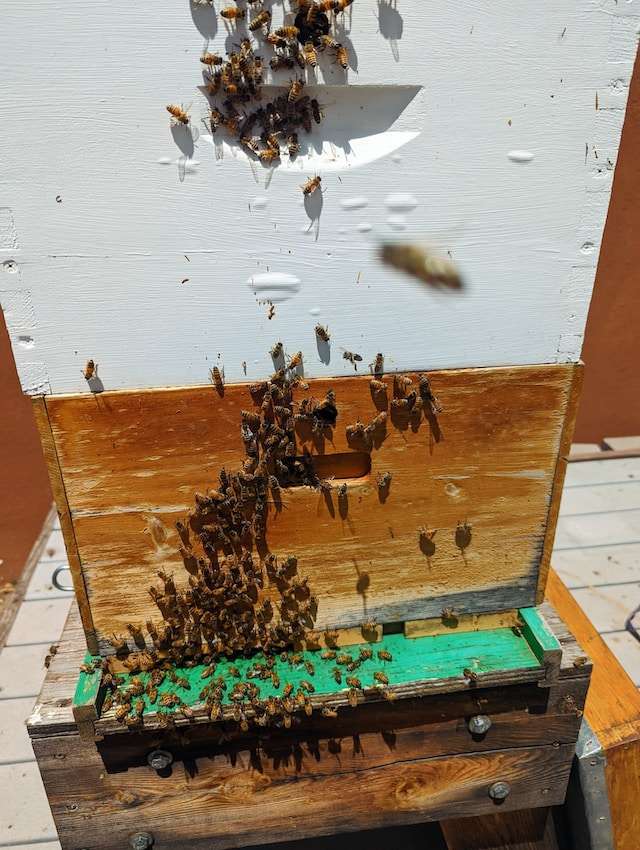
Climate Control
In beekeeping, creating the perfect environment for your bees is crucial for their overall health and productivity. One important aspect of hive management involves maintaining the hive’s temperature and controlling air circulation.
- Temperature Control: One of the primary roles of entrance reducers is to help regulate and maintain the temperature inside the hive. Just as humans seek shelter from extreme weather conditions, bees rely on their hive as a refuge. By utilizing entrance reducers, beekeepers can ensure that their bee colonies remain comfortable in various weather conditions.
- Winter Protection: During the harsh winter months, drafts and cold air entering the hive can be detrimental to the bees’ survival. Entrance reducers act as a barrier, reducing the entry of cold air into the hive. This feature is especially crucial for cold climates, where maintaining a warm hive is essential for the colony’s well-being and survival.
- Summer Management: Entrance reducers also play a pivotal role in preventing overheating during the scorching summer months. By reducing the size of the hive entrance, beekeepers can regulate the airflow within the hive, preventing excessive heat buildup. This helps to create a conducive environment for the bees, avoiding potential stress and ensuring optimal conditions for honey production.
- Optimal Hive Environment: To thrive and flourish, bees require specific environmental conditions within their hive. By employing entrance reducers, beekeepers can assist in creating the ideal atmosphere for the bees to live and work. This includes maintaining an appropriate temperature, proper air circulation, and overall hive stability.
- Assisting Air Circulation: Along with managing the temperature, entrance reducers also play a vital role in regulating air circulation within the hive. By controlling the size of the hive entrance, beekeepers can direct airflow and prevent the formation of stagnant pockets of air. This helps to maintain a fresh and well-ventilated environment, reducing the risk of diseases and ensuring the bees’ overall well-being.
Entrance reducers are indispensable tools in maintaining the ideal climate within a beehive. They assist beekeepers in creating a sheltered and comfortable environment for their colonies throughout the year. By reducing drafts and cold air infiltration during winter and preventing overheating during summer, entrance reducers help to ensure that the bees have the necessary conditions to thrive.
Swarm Control
In the beekeeping world, one of the most crucial aspects is preventing swarms. Swarming refers to the natural process in which a hive divides to form a new colony. While swarming is a natural phenomenon and a sign of a healthy bee colony, it can also pose challenges for beekeepers. This is where entrance reducers come into play.
- Reducing the Risk of Absconding: One of the primary benefits of entrance reducers is their ability to reduce the risk of absconding. Absconding occurs when the entire bee colony unexpectedly departs from the hive, leaving the beekeeper with an empty hive. By utilizing entrance reducers, beekeepers can significantly minimize this risk. By limiting the size of the hive entrance, entrance reducers make it more difficult for the bees to leave the hive in large numbers unnoticed. This ensures the bees remain within the hive, reducing the chances of absconding.
- Preventing Bees from Leaving Unnoticed: Another advantage of entrance reducers is that they prevent bees from leaving the hive without the beekeeper’s knowledge. When swarming is about to occur, bees often become more active near the hive entrance as they prepare for their departure. By using entrance reducers, beekeepers can easily monitor the hive entrance and quickly identify any increased bee activity. This enables beekeepers to take necessary swarm control measures promptly.
- Maintaining Bee Population: Maintaining the population of bees within the hive is crucial for the overall health and productivity of the colony. Entrance reducers play a vital role in this aspect. By reducing the size of the hive entrance, entrance reducers create a smaller space for bees to guard. This makes it easier for the colony to defend against intruders, such as pests or predators. Consequently, the bee population within the hive remains intact, ensuring the hive’s health and productivity.
- Minimizing Disruption to the Colony: When managing and controlling bee swarms, minimizing disruption to the colony is of utmost importance. Too much disturbance can lead to stress and potential complications within the hive. Entrance reducers aid in achieving this goal. By restricting the hive entrance, entrance reducers create a controlled environment for the bees. This minimizes external disturbances and allows the colony to function smoothly, enhancing their overall well-being.
- Assisting in Managing and Containing Bee Swarms: Last but not least, entrance reducers play a crucial role in managing and containing bee swarms. When installed properly, entrance reducers create a barrier that helps guide the bees out of the hive in a controlled manner during swarming. This allows beekeepers to capture and relocate the swarm to a desired location, preventing them from landing in unwanted areas or causing nuisance to the surrounding community. Additionally, entrance reducers assist in preventing bees from swarming too frequently, helping beekeepers maintain control over their colonies.
Entrance reducers are an essential tool for beekeepers to effectively control and manage bee swarms. By reducing the risk of absconding, preventing bees from leaving unnoticed, maintaining the bee population, minimizing disruption to the colony, and assisting in managing and containing bee swarms, entrance reducers play a significant role in the beekeeping process.
Pest Management
For beekeepers, maintaining a healthy and thriving bee population is essential. However, bees face numerous challenges, including the threat of pests and parasites.
- Controlling the Spread of Mites and other Parasites
One of the primary benefits of using entrance reducers is their ability to control the spread of mites and other parasites within the hive. These tiny pests can wreak havoc on bee colonies, causing significant harm and threatening the bee population. By using entrance reducers, beekeepers can create a barrier that restricts the entry of mites into the hive, thus minimizing infestations and mitigating potential damage.
- Reducing the Risk of Infestations by Pests such as Wax Moths
Wax moths are another common pest that pose a significant threat to bee colonies. These pests lay their eggs in beehives, and the resulting larvae can consume beeswax and honey, causing extensive damage. However, by implementing entrance reducers, beekeepers can reduce the risk of wax moth infestations. The narrower entrance created by the reducer makes it harder for wax moths to access the hive, thereby protecting the bees’ valuable resources.
- Minimizing the Chances of Small Animals Raiding the Hive for Honey
Small animals, such as skunks, bears, or raccoons, are often attracted to the sweet and nutritious honey stored in beehives. These unwelcome visitors can cause chaos and harm to the colony. By utilizing entrance reducers, beekeepers can significantly decrease the chances of skunks and other animals attempting to raid the hive for honey. The restricted entrance size makes it more challenging for animals to access the hive, keeping both the honey and the bees safe.
- Maintaining a Clean and Debris-free Hive
Entrance reducers also play a vital role in maintaining a clean and debris-free hive. By reducing the size of the hive entrance, beekeepers can effectively control the influx of debris, such as leaves, dirt, or dead bees, into the hive. This helps to create a cleaner and healthier environment for the bees, promoting their overall well-being and productivity.
- Ensuring the Health and Well-being of Bees
Ultimately, the usage of entrance reducers contributes to the overall health and well-being of the bee population. By implementing these simple tools, beekeepers can create a more secure and protected environment for their bees. This, in turn, ensures that the bees can focus on their essential activities, such as foraging, brood rearing, and honey production, without the constant threat of pests and invaders.
Entrance reducers are a valuable tool in pest management for beekeepers. Their ability to control the spread of mites and other parasites, reduce the risk of infestations by pests like wax moths, minimize the chances of small animal raids, maintain a clean and debris-free hive, and ensure the overall health and well-being of bees cannot be understated.
Conclusion
Incorporating an entrance reducer into your beekeeping practices offers numerous advantages for the welfare and productivity of your bee colony. From temperature and ventilation regulation to protecting the hive against predators and facilitating the establishment of new colonies, the benefits of using an entrance reducer are substantial. Moreover, it aids in minimizing robbing incidents and prevents drifting of bees, promoting a more harmonious and productive beekeeping environment.
FAQ
What is an entrance reducer in beekeeping, and why is it important?
- An entrance reducer is a device placed at the entrance of a bee hive to control the size of the entrance. It is important because it helps regulate ventilation, reduce potential predators, and prevent robbing from neighboring hives.
How does an entrance reducer enhance ventilation in the hive?
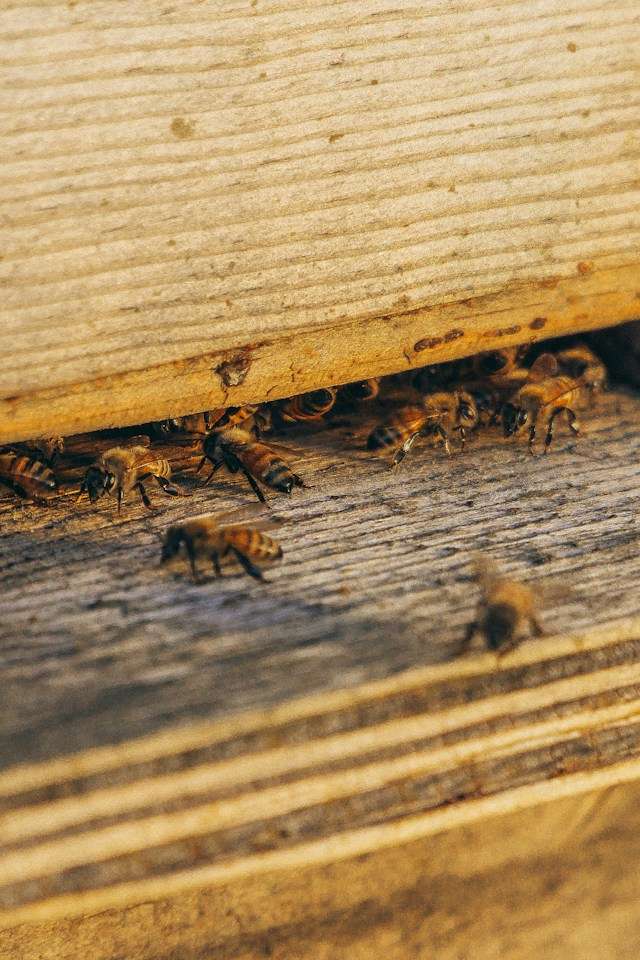
- By reducing the size of the entrance, an entrance reducer helps maintain a more controlled and stable internal temperature. This prevents excessive heat buildup in summer and limits cold drafts during winter, ensuring optimal hive conditions.
How do I install an entrance reducer in my hive?
- To install an entrance reducer, first, ensure your hive is properly leveled. Slide the entrance reducer into the hive entrance, positioning it securely. It should be flush against the hive and provide a reduced entrance size that meets your specific needs.
Will using an entrance reducer help protect my hive from potential predators?
- Yes, the reduced entrance size serves as a hindrance to larger predators like mice, birds, and wasps, preventing them from entering the hive. This protects your bees and their honey reserves from theft and potential damage.
Is there a specific time when I should use an entrance reducer?
- Entrance reducers should be used during weaker colony phases, such as when establishing a new hive or during periods of population decline. They can also be beneficial when dealing with nectar dearths, as they can help guard against robbing during scarcity.
Will an entrance reducer help prevent swarming?
- While an entrance reducer alone may not prevent swarming, it can indirectly assist in swarm prevention. By reducing the entrance, it encourages the bees to focus on defending the hive rather than venturing outside. Other swarm management techniques should also be employed to minimize swarming tendencies.
Can an entrance reducer help deter robbing from neighboring hives?
- Yes, robbing occurs when bees from other colonies invade a hive to steal its honey. By narrowing the entrance, an entrance reducer provides a manageable and defensible opening, making it harder for robbers to access the hive and decreasing the likelihood of robbing incidents.
Do I need to permanently use an entrance reducer?
- No, entrance reducers should be used temporarily and removed once the hive’s strength has increased or any specific threat to the hive has passed. This allows the bees to have a wider entrance when necessary for efficient foraging and population growth.
Are there different sizes of entrance reducers available?
- Yes, entrance reducers come in various sizes to accommodate different hive configurations and bee populations. It’s important to choose the appropriate size that matches your hive setup and current colony strength for optimal functionality.
Where can I purchase an entrance reducer for my beekeeping operation?
- Entrance reducers can be found at beekeeping supply stores, local beekeeping associations, or online beekeeping retailers. Ensure you purchase from reputable sources to ensure quality and compatibility with your hive.
